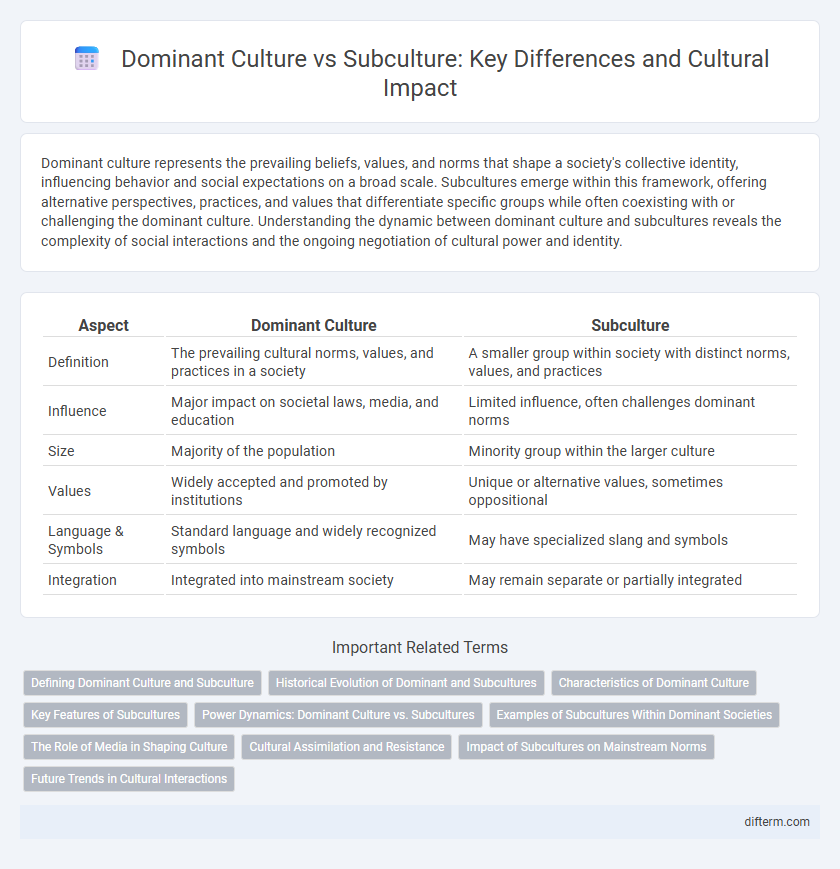Dominant culture represents the prevailing beliefs, values, and norms that shape a society's collective identity, influencing behavior and social expectations on a broad scale. Subcultures emerge within this framework, offering alternative perspectives, practices, and values that differentiate specific groups while often coexisting with or challenging the dominant culture. Understanding the dynamic between dominant culture and subcultures reveals the complexity of social interactions and the ongoing negotiation of cultural power and identity.
Table of Comparison
| Aspect | Dominant Culture | Subculture |
|---|---|---|
| Definition | The prevailing cultural norms, values, and practices in a society | A smaller group within society with distinct norms, values, and practices |
| Influence | Major impact on societal laws, media, and education | Limited influence, often challenges dominant norms |
| Size | Majority of the population | Minority group within the larger culture |
| Values | Widely accepted and promoted by institutions | Unique or alternative values, sometimes oppositional |
| Language & Symbols | Standard language and widely recognized symbols | May have specialized slang and symbols |
| Integration | Integrated into mainstream society | May remain separate or partially integrated |
Defining Dominant Culture and Subculture
Dominant culture represents the mainstream values, beliefs, and norms upheld by the majority within a society, influencing laws, media, and education systems. Subculture consists of distinct groups whose values, behaviors, and interests differ from or challenge those of the dominant culture, often emerging around shared interests, ethnicity, or lifestyles. Understanding the dynamics between dominant culture and subcultures reveals how societal cohesion and diversity coexist through cultural expression and adaptation.
Historical Evolution of Dominant and Subcultures
Dominant cultures have historically shaped societal norms, values, and institutions through mechanisms of power and control, often emerging from political, economic, and colonial dominance. Subcultures develop as distinct groups within or against the dominant culture, rooted in shared experiences, values, or resistance, evolving through social movements, migration, and generational shifts. The dynamic interplay between dominant cultures and subcultures drives cultural change, preserving heritage while fostering diversity and innovation.
Characteristics of Dominant Culture
Dominant culture is characterized by the widespread acceptance of its values, norms, and practices within a society, shaping social institutions, laws, and media. It typically holds the majority of power and influence, guiding societal expectations and behaviors while often marginalizing alternative perspectives. This culture's dominance ensures the continuation of its ideologies and cultural traditions across generations.
Key Features of Subcultures
Subcultures are distinct social groups within a dominant culture characterized by shared values, norms, and behaviors that differ from mainstream society. Key features include unique language, rituals, fashion, and belief systems that foster group identity and solidarity. These cultural traits often challenge or provide alternatives to the dominant culture, reflecting diversity in societal expressions.
Power Dynamics: Dominant Culture vs. Subcultures
Power dynamics between dominant culture and subcultures manifest through control over social norms, values, and institutions, often marginalizing minority groups. Dominant culture wields influence via political, economic, and media systems, shaping societal narratives that subcultures resist or adapt to maintain distinct identities. The tension highlights ongoing struggles for recognition, equity, and cultural preservation within multicultural societies.
Examples of Subcultures Within Dominant Societies
Subcultures within dominant societies often emerge around distinct interests, lifestyles, or shared values that differ from mainstream norms, such as the punk rock scene emphasizing anti-establishment views and unique fashion, or the hip-hop community promoting artistic expression and social justice. Other examples include goth subculture with its distinctive aesthetic and focus on individuality, and tech enthusiasts who prioritize innovation and digital connectivity. These subcultures contribute to cultural diversity by challenging dominant cultural narratives and creating alternative social identities.
The Role of Media in Shaping Culture
Media plays a pivotal role in shaping both dominant cultures and subcultures by disseminating symbols, values, and narratives that influence public perception and identity formation. Dominant culture is reinforced through mainstream media channels such as national television, major newspapers, and popular social media platforms, which propagate widely accepted cultural norms and ideologies. Conversely, subcultures utilize niche media outlets, underground publications, and specialized online communities to express distinct identities and challenge dominant cultural paradigms.
Cultural Assimilation and Resistance
Dominant culture sets the prevailing norms, values, and practices that shape societal expectations, while subcultures develop distinct identities often based on ethnicity, interests, or social class. Cultural assimilation occurs when subcultures gradually adopt elements of the dominant culture, leading to diminished cultural distinctiveness. Resistance emerges as subcultures actively preserve their unique traditions and challenge dominant cultural norms to maintain identity and autonomy.
Impact of Subcultures on Mainstream Norms
Subcultures influence mainstream norms by introducing alternative values, styles, and behaviors that challenge prevailing cultural expectations. These groups often act as catalysts for social change, pushing dominant culture to adapt through the incorporation of new ideas and practices. The dynamic interaction between dominant culture and subcultures fosters cultural diversity and innovation within society.
Future Trends in Cultural Interactions
Dominant culture shapes societal norms and values, but emerging subcultures increasingly influence global trends through digital connectivity and multicultural exchanges. Future cultural interactions will emphasize hybrid identities, blending traditional dominant cultural elements with innovative subcultural expressions. Advances in technology and globalization will accelerate these dynamic interactions, fostering inclusivity and cultural fluidity.
Dominant culture vs Subculture Infographic

 difterm.com
difterm.com